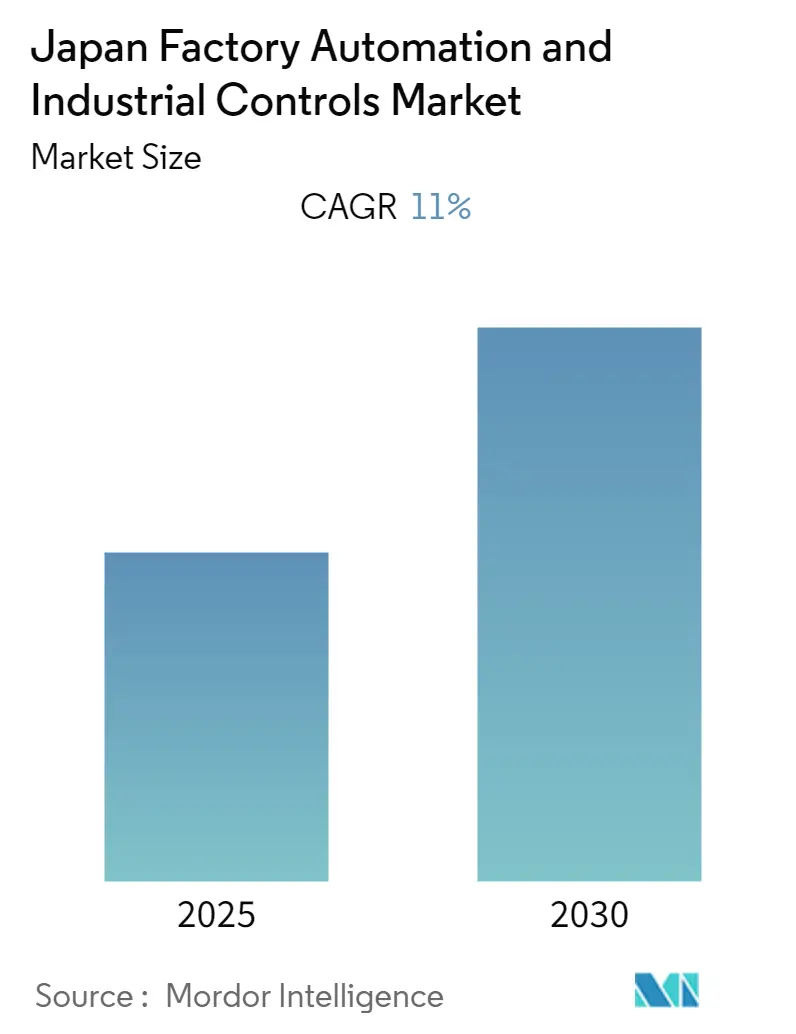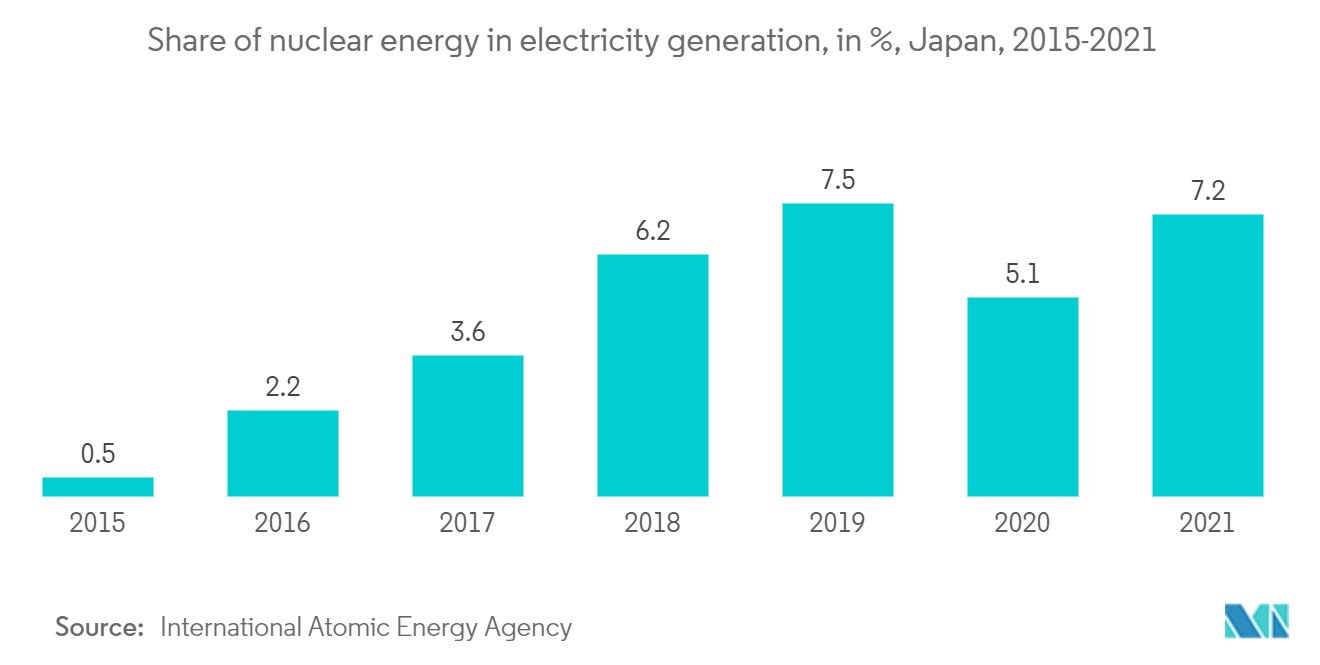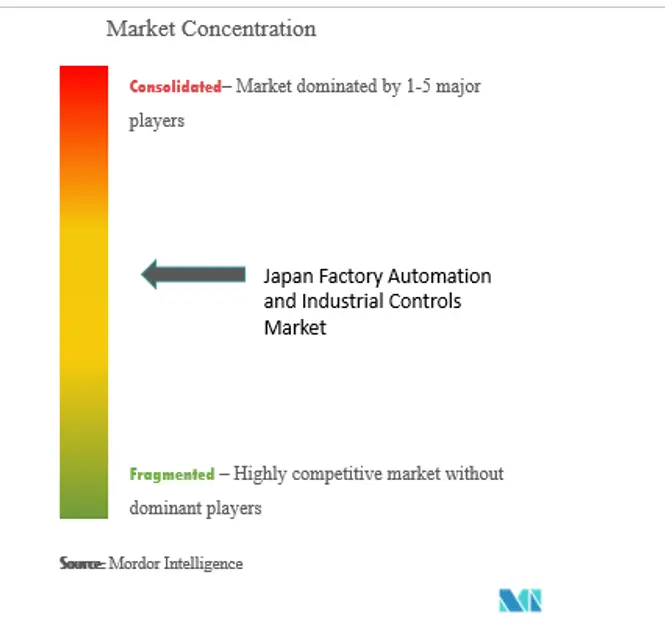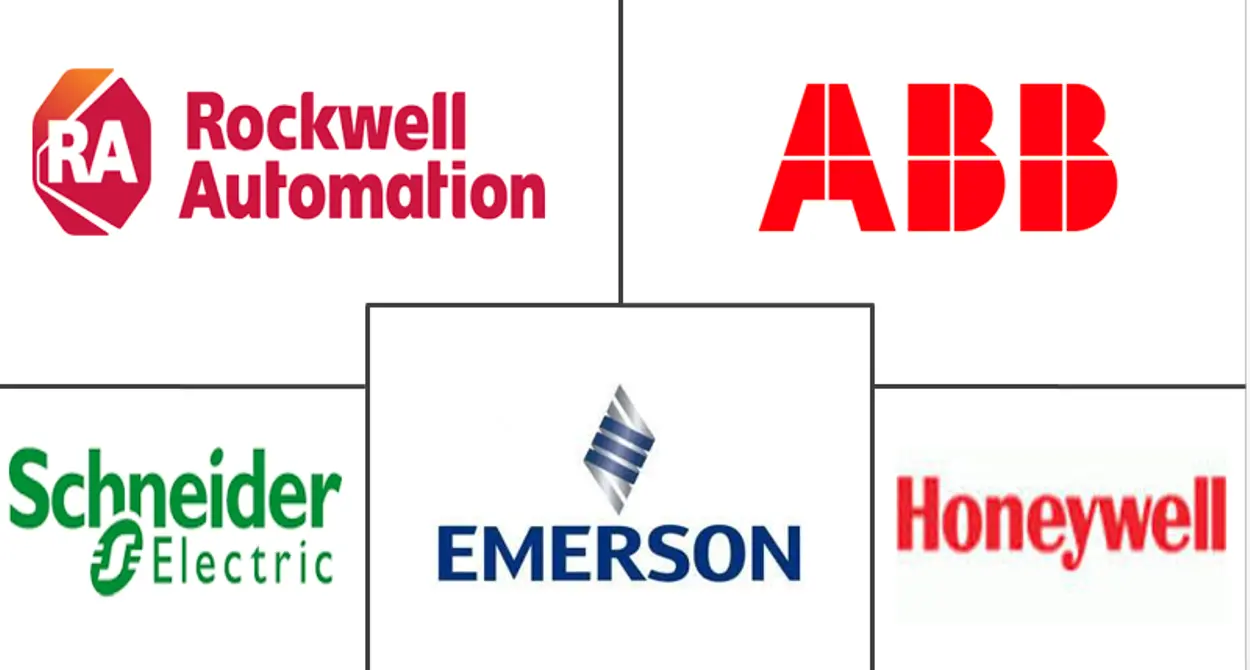
Japan Factory Automation & Industrial Controls Market Analysis
The Japan Factory Automation and Industrial Controls Market is expected to register a CAGR of 11% during the forecast period.
- Automation of manufacturing processes has presented several benefits like effortless monitoring, waste reduction, and production speed. This technology offers customers improved quality with standardization and reliable products within time and at a cheaper cost.
- Connecting the industrial equipment & machinery and acquiring real-time data have played a critical role in the adoption of PLC systems, SCADA, HMI, and software that offer visualization; thus, enabling decreasing the faults in the product, scheduling maintenance, reducing downtime, and switching from being in the reactive state to predictive and prescriptive stages for decision-making.
- The Industrial 4.0 and the Industrial Internet of Things (IIOT) are at the center of new technological approaches for the development, production, and management of the entire logistics chain, otherwise known as smart factory automation, and are dominating trends in the industrial sector, with machinery and devices being connected via the internet.
- Moreover, massive shifts in manufacturing due to industry 4.0 and the acceptance of IoT require enterprises to adopt agile, smarter, and innovative ways to advance production with technologies that complement and augment human labor with automation and reduce industrial accidents caused by process failure.
- According to Zebra's latest Manufacturing Vision Study, smart asset tracking solutions based on IoT and RFID are envisioned to overtake traditional, spreadsheet-based methods by 2022. A study by Industrial IoT (IIoT) company, Microsoft Corporation, established that 85% of companies have at least one IIoT use case project. This number is foreseen to increase, as 94% of respondents said they would implement IIoT strategies by 2021.
- Further, Japan has been a pioneer in transforming into an automated industrial economy. The Industrial version 4.0 is being adopted at a faster pace. The country has materialized as a manufacturing hub for factory automation products and supplies them to other Asian-Pacific regional markets. Also, the presence of multiple automobile manufacturers, the electronic products manufacturing industry, food processing industry makes Japan an important market.
- The COVID-19 pandemic posed many challenges for the manufacturing industry in Japan. The profound change in consumer behavior because of the COVID-19 pandemic is expected to lead to more automation and virtualization. Smart factories and offices are expected to increase, allowing critical functions that currently need to be overseen in person to be monitored remotely or, at a minimum, by fewer people. Hence, the market is predicted to grow during the forecast period. Following the global economic recession led by COVID-19, the factory automation market in Japan noticed a mixed impact from the supply side and a positive effect from the demand side in 1st half of 2020.
- Smart factory initiatives have helped manufacturers to overcome COVID-19 challenges and address issues such as workforce reductions, drops in sales for some specific products, social distancing, and extreme pressure to cut operational costs since most enterprises operating in the end-user industries (majorly manufacturing, automotive) had shuttered down their production sites due to lockdown restrictions.
Japan Factory Automation & Industrial Controls Market Trends
Distributed Control Systems are Expected to Witness a Significant Market Growth
- Distributed Control Systems (DCS) are process-oriented platforms that rely on a network of interconnected sensors, actuators, and controllers, terminals to act as a centralized master controller for a facility's production operations. Resultantly, a DCS focuses on controlling and monitoring processes and allowing facility operators to see all facility operations in one place. DCS enables the implementation of advanced process automation strategies as it operates on a closed-loop control platform. Thus, DCS is suitable for controlling operations at a single facility or factory. Further, a DCS is crucial for maximizing the visibility of a facility's everyday operational processes.
- The control architecture includes a supervisory level of control, overseeing multiply-integrated sub-systems, responsible for controlling the details of a localized process. They are connected to sensors and actuators and utilize setpoint control to control material flow through the plant.
- One of the important benefits of the DCS systems is that the digital communication between workstations, distributed controllers, and other computing elements follows the peer-to-peer access principle. These prerequisites have driven the adoption of DCS, as these systems provide lower operational complexity, project risk, and functionalities like flexibility for agile manufacturing in highly-demanding applications. The ability of DCS to integrate PLCs, turbomachinery controls, safety systems, third-party controls, and various other plant process controls for heat exchangers, feedwater heaters, and water quality, among others, further drives the adoption of DCS in the energy sector.
- With Japan's growing demand for energy, the interest in constructing new power plants over the next 15 to 20 years has increased. This has challenged the nuclear industry to provide a high construction volume. A key strategy to meet this challenge is developing an advanced nuclear power plant design that allows for modular construction, a high level of standardization, passive safety features, a reduced number of components, and a short bid-to-build time. Resultantly, it offers lucrative opportunities for the growth of the studied market.
- There is also an increase in the usage of Distributed Control systems in nuclear power plants, chemical, petrochemical, metallurgical plants, etc., due to minimal troubleshooting requirements, engineering time, enhanced efficiency, etc. This trend is anticipated to drive the growth of the studied market significantly.
- While Distributed Control Systems have delivered an efficient solution for managing the functions required to keep plants operating safely and efficiently, they are struggling to meet the expectations stemming from the emergence of digital technologies in the industrial space. While developments in Japan like smart instrumentation and sensors utilizing IIoT technologies are transforming possibilities for control and access to data, the hardships of integrating them into Distributed Control Systems have meant that, in some cases, their highest potential has remained predominantly unrealized. Therefore, there is a massive demand for innovative and agile DCS without compromising their primary role of reliably and safely controlling and coordinating large numbers of regional production assets.

Industrial Robots are Anticipated to Hold a Major Market Share
- Japan is a major player in the production of robots and factory automation systems. With its well-developed robotic sector and automation technologies, Japan is one of the leading countries to employ robotics and automation in production processes globally. According to the Statistics Bureau of Japan, the industry revenue of robots in the country is likely to reach USD 16.35 billion in 2024 from USD 10.18 billion in 2018.
- Japan's current leadership in robotics was built on a long history of technological leadership in manufacturing. Currently, Japanese automation companies are benefiting from strong growth in demand for their products.
- With increased demand across economies, product manufacturers are adopting robots to automate some of the repetitive processes. The industrial robot market has witnessed a huge demand over the past decade, owing to the rising adoption of smart factory systems. These robots play a crucial part.
- Industry 4.0, the most recent industrial revolution, has fueled the evolution of new technologies, like collaborative robots, AI-enabled robots, etc., and has facilitated enterprises to utilize robots to streamline many processes, improve efficiency, and eliminate errors. Augmented workplace safety and improved production capabilities have further driven industries to invest in robotic systems.
- Additionally, industrial robots are becoming smaller and cheaper without compromising quality; the market is becoming attractive for key players in several end-user industries. However, higher investments may hamper the growth of the market. The upsurge in demand for industrial robots in Japan was triggered by a shortage of workers who remained off duty because of COVID-19-related lockdowns and an upgrade of traditional industries.

Japan Factory Automation & Industrial Controls Industry Overview
The Japan Factory Automation and Industrial Control Market is a moderately consolidated market with several firms in the market, each having a small level of market dominance. Industry 4.0 and digitalization initiatives across regions provide lucrative opportunities in the industrial robots market.
- March 2022 - Mitsubishi Electric Corporation announced that it had acquired 42,000 square meters of land in OwariasahiCity, Aichi Prefecture, Japan, to establish a new production site to manufacture factory automation (FA) control system products from April 2025. The new factory would employ numerous advanced technologies like 5G communication, permitting simultaneous connection of machines, automatic guided vehicles (AGVs), and human workers as they perform their manufacturing duties. In parallel, real-time and high-speed data acquisition throughout the factory will deliver data sets on all facets of the production cycle for Artificial Intelligence based analysis to realize a flexible and safe production environment.
- February 2022 - Yamaha Revealed Initiatives to Support Factory-automation Sales Network. Yamaha Motor Robotics Factory Automation section has held its 2022 annual distributor meeting online. Among new initiatives revealed during the meeting, a new online portal for agents was introduced that accelerates solution integration and customer support by easing access to parts and setup information. In addition, the main Yamaha industrial robots website is claimed to provide extra help to configure, program, and operate the robots and add capabilities like tracking.
Japan Factory Automation & Industrial Controls Market Leaders
-
Rockwell Automation
-
ABB Ltd
-
Emerson Electric
-
Honeywell Intenational Inc
-
Schneider Electric
- *Disclaimer: Major Players sorted in no particular order

Japan Factory Automation & Industrial Controls Market News
- May 2022 - Kawasaki Heavy Industries developed a humanoid robot that works like humans outside factories and exhibited it in Tokyo. The company sports a Group Vision 2030, appealing for robotics technology in two areas: safety and security in remote societies and mobility in the future. In the area of the safety and security of remote society, the company exhibited the "HINOTORI," a Medic-aid or a surgical support robot.
- April 2022 - Japan's Yaskawa Company has developed an Industrial robot with artificial intelligence which determines the color and shape of the objects and transports them to their correct position. The company is evolving in several fields, like the automobile industry and parts manufacturing.
Japan Factory Automation & Industrial Controls Industry Segmentation
The study characterizes the market based on the type of products, such as SCADA, DCS, PLC and robotics, among others, and by End-user industries that include Oil & Gas, Chemical & Petrochemical, Power and Food and Beverage, among others. The scope of the study is currently focused on Japan.
| By Type | Industrial Control Systems | Distributed Control System (DCS) | |
| Programable Logic Controller (PLC) | |||
| Supervisory Control and Data Acquisition (SCADA) | |||
| Product Lifecycle Management (PLM) | |||
| Manufacturing Execution System (MES) | |||
| Human Machine Interface (HMI) | |||
| Other Industrial Control Systems | |||
| Field Devices | Machine Vision | ||
| Industrial Robotics | |||
| Sensors and Transmitters | |||
| Motors and Drives | |||
| Safety Systems | |||
| Other Field Devices | |||
| By End-user Industry | Oil and Gas | ||
| Chemical and Petrochemical | |||
| Power and Utilities | |||
| Food and Beverage | |||
| Automotive and Transportation | |||
| Other End-user Industries | |||
Japan Factory Automation & Industrial Controls Market Research FAQs
What is the current Japan Factory Automation and Industrial Controls Market size?
The Japan Factory Automation and Industrial Controls Market is projected to register a CAGR of 11% during the forecast period (2025-2030)
Who are the key players in Japan Factory Automation and Industrial Controls Market?
Rockwell Automation, ABB Ltd, Emerson Electric, Honeywell Intenational Inc and Schneider Electric are the major companies operating in the Japan Factory Automation and Industrial Controls Market.
What years does this Japan Factory Automation and Industrial Controls Market cover?
The report covers the Japan Factory Automation and Industrial Controls Market historical market size for years: 2019, 2020, 2021, 2022, 2023 and 2024. The report also forecasts the Japan Factory Automation and Industrial Controls Market size for years: 2025, 2026, 2027, 2028, 2029 and 2030.
Our Best Selling Reports
Japan Factory Automation & Industrial Controls Industry Report
Statistics for the 2025 Japan Factory Automation and Industrial Controls market share, size and revenue growth rate, created by Mordor Intelligence™ Industry Reports. Japan Factory Automation and Industrial Controls analysis includes a market forecast outlook for 2025 to 2030 and historical overview. Get a sample of this industry analysis as a free report PDF download.



